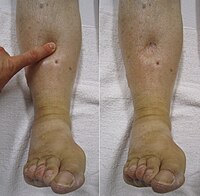
Photo from wikipedia
Muscle protein was one of critical accumulation protein for anthropogenic chemicals. However, few predictive models were constructed for muscle protein up to now. In addition, some ionizable chemicals classes e.g.… Click to show full abstract
Muscle protein was one of critical accumulation protein for anthropogenic chemicals. However, few predictive models were constructed for muscle protein up to now. In addition, some ionizable chemicals classes e.g. sulfonates were not successfully modeled in previously models, indicating considerable work would be needed. The major objective of this study was to develop quantitative structure-activity relationship (QSAR) models for predicting the muscle protein-water partition coefficient (logKMP/w) of chicken and fish. In the modeling, the n-octanol/water distribution coefficient (logD), functional groups, atom-centred fragments and chemical form adjusted descriptors were used to construct the models. The application domain of the derived models was defined by the Euclidean distance-based method and Williams plot. The modeling results indicated that the determination coefficient (R2), leave-one out cross validation Q2 (Q2LOO) and bootstrapping coefficient (Q2BOOT) of the QSAR models for chicken and fish were 0.882 and 0.929, 0.844 and 0.906, 0.779 and 0.792, respectively, implying the models had good goodness-of-fit and robustness. The coefficient determination (R2EXT) and external validation coefficient (Q2EXT) of the validation set for the two models were 0.874 and 0.937, 0.869 and 0.915, respectively, indicating the models had good predictive ability. The predictor variables selected to construct the logKMP/w models of chicken and fish included logD, the function groups, and the fraction of the ionized species (δI). Considering the molecular descriptors used here can be calculated from their molecular structures directly, the developed models could be easily used to fill the logKMP/w data gap for other chemicals within the applicability domain.
Journal Title: Ecotoxicology and environmental safety
Year Published: 2018
Link to full text (if available)
Share on Social Media: Sign Up to like & get
recommendations!